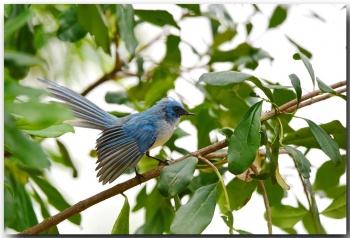m (resize picture to fit alternative name in 1024x768) |
m (→External Links: {{GS-checked}} <br /> <br />) |
||
| (9 intermediate revisions by 4 users not shown) | |||
| Line 1: | Line 1: | ||
| − | [[Image: | + | [[Image:African Blue FlycatcherCr.jpg|thumb|550px|right|Photo © by {{user|Steve+G|Steve G}} <br /> [[Kakamega]], [[Kenya]], July, 2011]] |
| − | '''Alternative name: Blue Crested Flycatcher''' | + | '''Alternative name: Blue Crested Flycatcher'''<sup>[[#Taxonomy|[1]]]</sup> |
;[[:Category:Elminia|Elminia]] longicauda | ;[[:Category:Elminia|Elminia]] longicauda | ||
| − | |||
==Identification== | ==Identification== | ||
| − | '''Male''' | + | [[Image:23544african_blue_flycatcher.jpg|thumb|400px|right|Adult of race ''teresita''<br />Photo © by {{user|MURAMURA|MURAMURA}}<br />Mbarara, Katojo, western [[Uganda]]<br />December 2006]] |
| − | + | 15–18 cm (6-7 in)<br /> | |
| + | '''Male''' <br /> | ||
| + | *Cobalt blue upperparts and throat | ||
| + | *Lighter below | ||
| + | *Long tail<br /> | ||
| + | '''Females''' and '''immatures'''<br /> | ||
| + | *Grey | ||
| + | *Narrow band of blue on edges of wing and tail-feathers. | ||
==Distribution== | ==Distribution== | ||
| − | Equatorial [[Africa]] | + | Equatorial [[Africa]]<br /> |
| + | '''Western Africa''': [[Senegambia]], [[Senegal]], The [[Gambia]], [[Guinea-Bissau]], [[Guinea]], [[Mali]], [[Sierra Leone]], [[Liberia]], [[Ivory Coast]], [[Burkina Faso]], [[Ghana]], [[Togo]], [[Benin]], [[Nigeria]], [[Niger]], [[Chad]], [[Cameroon]], [[Central African Republic]], [[Equatorial Guinea]], [[Gabon]], [[Congo]], [[Angola]]<br /> | ||
| + | '''Eastern Africa''': [[South Sudan]], [[Kenya]], [[Uganda]], [[Rwanda]], [[Burundi]], [[Tanzania]], [[Malawi]] | ||
==Taxonomy== | ==Taxonomy== | ||
| − | + | Sometimes considered a superspecies with the [[White-tailed Blue-Flycatcher]], ''E. albicauda''.<br /> | |
| − | The alternative name Blue Crested Flycatcher may lead to confusion with [[Blue-crested Flycatcher]], ''Myiagra azureocapilla''. | + | #The alternative name Blue Crested Flycatcher may lead to confusion with [[Blue-crested Flycatcher]], ''Myiagra azureocapilla''. |
| + | ====Subspecies==== | ||
| + | [[Image:DSC 9057.JPG|thumb|350px|right|Photo © by {{user|volker+sthamer|volker sthamer}}<br />Queen Elizabeth National Park, Uganda, January 2019]] | ||
| + | This is a [[Dictionary_P-S#P|polytypic]] species<sup>[[#References|[1]]]</sup> consisting of two subspecies<sup>[[#References|[1]]]</sup>: | ||
| + | *''E. l. longicauda'': | ||
| + | :*[[Senegal]] to [[Gambia]] and [[Nigeria]] | ||
| + | *''E. l. teresita'': | ||
| + | :*[[Cameroon]] and [[Gabon]] east across northern [[Democratic Republic of the Congo]] to southern [[Central African Republic]], southwestern [[South Sudan]], [[Uganda]], and western [[Kenya]] | ||
==Habitat== | ==Habitat== | ||
| − | Open secondary forest, swampy or riverine forests, and wooded savannas, cleared and abandoned fruit and cocoa plantations. | + | Open secondary forest, mangrove, swampy or riverine forests, and wooded savannas, cleared and abandoned fruit and cocoa plantations. |
| − | |||
==Behaviour== | ==Behaviour== | ||
| − | The diet | + | ====Diet==== |
| − | + | The diet consists almost entirely of insects such as bees, ants, flies, termites and beetles, which can be hawked or gleaned. | |
| − | + | ====Breeding==== | |
| − | + | They construct a compact, cup-shaped nest. The clutch contains 1-2 white eggs which are incubated by the female. Both parents feed the young, with assistance from non-breeding adults or immatures in the group. | |
| + | ==References== | ||
| + | #{{Ref-Clements6thAug18}}#Avibase | ||
| + | #Answers.com | ||
| + | #Handbook of the Birds of the World Alive (retrieved March 2019) | ||
| + | {{ref}} | ||
==External Links== | ==External Links== | ||
{{GSearch|Elminia+longicauda}} | {{GSearch|Elminia+longicauda}} | ||
[[Category:Birds]] [[Category:Elminia]] | [[Category:Birds]] [[Category:Elminia]] | ||
| + | {{GS-checked}} | ||
| + | <br /> | ||
| + | <br /> | ||
Latest revision as of 08:02, 26 November 2021
Alternative name: Blue Crested Flycatcher[1]
- Elminia longicauda
Identification
15–18 cm (6-7 in)
Male
- Cobalt blue upperparts and throat
- Lighter below
- Long tail
Females and immatures
- Grey
- Narrow band of blue on edges of wing and tail-feathers.
Distribution
Equatorial Africa
Western Africa: Senegambia, Senegal, The Gambia, Guinea-Bissau, Guinea, Mali, Sierra Leone, Liberia, Ivory Coast, Burkina Faso, Ghana, Togo, Benin, Nigeria, Niger, Chad, Cameroon, Central African Republic, Equatorial Guinea, Gabon, Congo, Angola
Eastern Africa: South Sudan, Kenya, Uganda, Rwanda, Burundi, Tanzania, Malawi
Taxonomy
Sometimes considered a superspecies with the White-tailed Blue-Flycatcher, E. albicauda.
- The alternative name Blue Crested Flycatcher may lead to confusion with Blue-crested Flycatcher, Myiagra azureocapilla.
Subspecies
This is a polytypic species[1] consisting of two subspecies[1]:
- E. l. longicauda:
- E. l. teresita:
- Cameroon and Gabon east across northern Democratic Republic of the Congo to southern Central African Republic, southwestern South Sudan, Uganda, and western Kenya
Habitat
Open secondary forest, mangrove, swampy or riverine forests, and wooded savannas, cleared and abandoned fruit and cocoa plantations.
Behaviour
Diet
The diet consists almost entirely of insects such as bees, ants, flies, termites and beetles, which can be hawked or gleaned.
Breeding
They construct a compact, cup-shaped nest. The clutch contains 1-2 white eggs which are incubated by the female. Both parents feed the young, with assistance from non-breeding adults or immatures in the group.
References
- Clements, J. F., T. S. Schulenberg, M. J. Iliff, D. Roberson, T. A. Fredericks, B. L. Sullivan, and C. L. Wood. 2018. The eBird/Clements checklist of birds of the world: v2018. Downloaded from http://www.birds.cornell.edu/clementschecklist/download/
- Avibase
- Answers.com
- Handbook of the Birds of the World Alive (retrieved March 2019)
Recommended Citation
- BirdForum Opus contributors. (2024) African Blue Flycatcher. In: BirdForum, the forum for wild birds and birding. Retrieved 12 May 2024 from https://www.birdforum.net/opus/African_Blue_Flycatcher
External Links
GSearch checked for 2020 platform.






